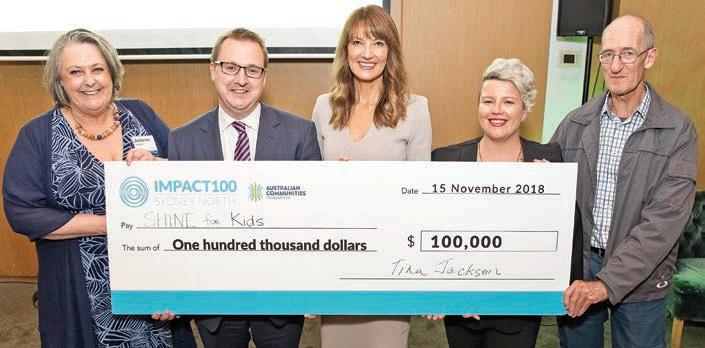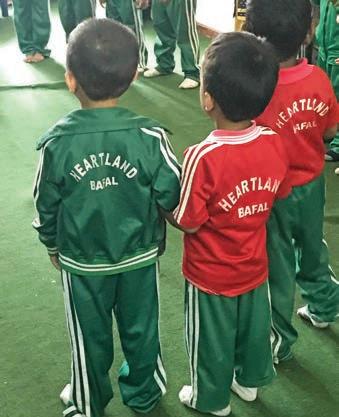
6 minute read
Philanthropy feature
Taking philanthropy mainstream
The term ‘philanthropy’ can evoke images of high net worth individuals bequeathing large sums of money to worthwhile causes, yet new ways of giving are making the space more accessible to everyone — regardless of how much they can afford to give. By Jocelyn Biddle
With social issues on this rise, it’s a necessary change as pressure on the charitable dollar increases. In 201718 alone, another 2830 charities commenced in Australia.
Sarah Wickham is the Policy & Research Manager with charity sector association Philanthropy Australia. She says that the combination of complex social issues and our increasing social conscience has seen many new charities start up to address these concerns.
According to the 2016 Australian Charities Report published by the Australian Charities and Not-for-profits Commission (ACNC), there are now over 56,000 registered charities in Australia. This number includes not-for-profit organisations such as universities, aged care centres, religious institutions and non-government schools. However, despite the size of the sector, Australia still has fewer charities per capita than Canada, USA, UK and New Zealand.
Wickham says that the traditional notion of philanthropy has evolved, so that it now comprises three elements – namely time, talent and treasure.
“Whereas philanthropy used to be about signing a cheque, there is now a changing trend as people recognise that giving your time is just as important. Volunteering can really increase a charity’s ability to make a difference,” says Wickham. “Philanthropy applies to giving at every level. Regardless of how much you can afford, it’s about giving with intent, using a considered approach to identify your particular passion and helping to make a difference that’s within your means.” McCrindle Research recently released its Australian Community Trends report to
Sarah Wickham examine the effectiveness, engagement and awareness of the not-for-profit sector. Its survey of over 1500 Australians showed that charitable giving remains strong in Australia, with 5 in 6 Australians supporting charities or NFP organisations. Almost one third of respondents had volunteered in the past 12 months with key motivators including a responsibility to give back to the community (56%); to make the world a better place (50%); and the feeling they get when they volunteer (47%).
Crowdfunding
With thousands of charities requiring support, the sector is continually looking for new ways to attract funding. And one initiative that is having a very positive impact, particularly for grassroots charities, is crowdfunding. A relatively new concept for Australia, it involves bringing groups of people together to jointly fund a project or social social change. Through leverage of the group, participants can see how their donation goes much further. Julie McDonald is the CEO of crowdfunding organisation The Funding Network (TFN). She says grassroots charities are undertaking great social innovation - often in areas not being covered off by larger charities - however they receive little funding. This is substantiated in JB Were’s ‘The Evolution of Philanthropy’ report released in June 2018, which showed that the top 10% of charities receive 94% of donations and bequests. To address this gap, TFN holds events around Australia to which likely donors are invited to listen to pitches by smaller charities at the forefront of social change. Following the pitches, audience members are invited to support their chosen charity. “You don’t need to be wealthy to be a philanthropist,” says McDonald. “By pooling funds, our audience can see how they are making a difference with however much they can afford. “Each charity delivers a compelling pitch and audience members can ask questions to better understand areas of need and how their money will be used. It’s a really powerful forum. When you’re in the moment and you are seeing first-hand what the charity is trying to achieve, it becomes very compelling.” With anywhere from 150-250 people attending each event, an average $100,000 — $150,000 is raised in an evening. Through this forum, TFN has raised $10 million in the past 5 years. TFN’s McDonald says that a democratic process is used to select the charities. Anywhere from 30 to 60 charities apply for each event and an extensive due diligence process takes place (including review by an external panel) to develop the shortlist.
Julie McDonald

IMPACT100 Sydney North members last year voted to award $100,000 to SHINE for Kids.



Creating an impact
Another organisation engaged in crowdfunding for the charity sector is IMPACT100. Established in Sydney in 2015, IMPACT100 now has two chapters - one in the CBD and the other on the north shore.
Each year, IMPACT100 creates a ‘giving circle’ comprising 100 members who each donate $1,000. The resulting $100,000 is then given as a ‘transformational grant’ to one charity selected by members. Tina Jackson started the North Shore chapter of IMPACT100 in 2017 in a bid to help grow a culture of giving and to make philanthropy more accessible. “People really want to make a difference in their local communities. The extent of the need is great and through our work, we are coming across many different approaches to addressing social issues, often driven by the passion of individuals.”
IMPACT100 receives around 60 applications each year from grassroots charities seeking support. Four finalists are shortlisted to pitch at their annual event, with members then voting to decide which one will receive the $100 thousand grant. “The program is having a ripple effect, as members often decide to volunteer or do pro bono work after finding out more about the charities working in their community.” Last year, IMPACT100 Sydney North selected SHINE for Kids (supporting young people with incarcerated parents) to receive the $100,000 grant. The three other finalists were the Pyjama Foundation (empowering children in foster care by giving them life skills and confidence); Dandelion Support Network (providing essential items for babies and children to families in need); and SISTER2sister (offering youth support and education programs for marginalised girls). Giving is an important practice for a connected country. But with so many charities needing support, it’s not surprising that people are looking at where their donations will have the highest impact – often on the basis of an emotional connection or past experience. Whether giving time, money or both, the good news is that giving circles and crowdfunding is opening up the world of philanthropy so that it is accessible to everyone – regardless of how much you can afford to donate.


A visit to Nepal in 2006 impacted Lane Cove’s Patrick Price to such an extent, that he decided to start a charity that is changing educational outcomes for thousands of children in that country. Pat established the Centre for Learning and Children's Rights (CLCR) in 2007 and this Australian not-for-profit organisation is now delivering educational and humanitarian projects in Nepal through its volunteer work, project implementation and skills training. Pat manages his work with the charity in his spare time, in between juggling commitments with his young family and his full-time position with the NSW Department of Education. “It gives my life great meaning. We’ve had some great turn arounds since we started it. Upwards of 10,000 kids have come through our school and we’ve helped change their lives by providing a positive learning experience.”
The charity landscape†
If you are interested in attending a crowdfunding event or joining a $ giving circle to support grassroots charity organisations, see Charities Total revenue Paid staff 52,166 $143 BIL 1.3 MILwww.thefundingnetwork.com.au or www.impact100sydneynorth.org Volunteers 2.9 MIL
5 in 6 Australians give financially to charities or not-for-profits (83%)
1 in 4 (27%) give at least once a month However, 1 in 6 (17%) don’t give at all
Most of these give in other ways too
66% - Donating goods
32% - Volunteering
23% - Fundraising/promoting
21% - Raising awareness
Z
Gen Z’s are the most likely to have volunteered for a charity in the past 12 months - 44%







